Trade Flow Optimization Model for Plastic Pollution Reduction
Abstract
1. Introduction
2. Materials and Methods
2.1. Data
- Plastic trade flow: We download the country-to-country trade flow of different plastic products from the World Bank database.
- Country code: We download the alpha-3 code and numeric code for each country (Link for data download: https://www.iban.com/country-codes (accessed on 12 November 2021), [IBAN:country codes alpha-2 and alpha-3]) in order to aggregate the information from different data sources.
- Oil production by country: We download the oil production data for different countries in 2010 from the “Our World in Data” website (Link for data download: https://ourworldindata.org/fossil-fuels (accessed on 12 November 2021), [Our World in Data: Oil production]). We use this to reflect each country’s capacity for producing raw materials for plastic production. This is used to estimate capacities in Stage I of our model.
- Industrial GDP by country: We download the GDP of the industrial sector by country from Statistics Times website (Link for data download: https://statisticstimes.com/economy/countries-by-gdp-sector-composition.php (accessed on 13 November 2021), [Statistics Times: Industrial GDP]). We use this to reflect the production of plastic products in each country. This is used to estimate capacities in Stage II of our model.
- Aggregate consumption by country: We download the aggregate consumption data from the World Bank database (Link for data download: https://data.worldbank.org/indicator/NE.CON.TOTL.ZS (accessed on 13 November 2021), [World Bank: Aggregate consumption]). We use this to reflect the demands of plastic products in each country. This is used to estimate capacities in Stage III of our model.
- Municipal solid waste recycle rate by country: We download data for a selected list of countries from Statista website (Link for data download: https://www.statista.com/statistics/1052439/rate-of-msw-recycling-worldwide-by-key-country/ (accessed on 13 November 2021), [Statista: Municipal solid waste recycle rates]). We use this as a proxy for plastic waste recycle rate. This is used to estimate capacities in Stage V of our model.
- Plastic trade data: We use the same year of the world trade data and the data to aggregate. For example, in our trade flows optimization model, we use the 2010 world trade data because the mismanaged rate data are measured in 2010 [2]. We use the average trade volume of the import of country A from country B and the export of country B to country A as the final trade volume of the specific form of the plastic from country B to country A. The final trade volume between country A and country B is further used as the parameter for trade capacity in the trade flows optimization model.
- Mismanaged plastic waste data: We use the average mismanaged plastic waste rate of the countries with available data to impute the mismanaged plastic waste rate of the countries without the information. Mismanaged plastic waste rate is defined as the proportion of total plastic waste generation.
- Plastic waste recycle rate: Because we only have recycle rates for key countries in the data downloaded (32 countries in total), we impute the recycle rates by first fitting a regression of recycle rate on GDP per capita for the countries we have data for and then getting the predicted values for all countries. A practical justification is provided in Section 3.1.
2.2. Model
2.2.1. Stages of Plastic Flow and Problem Statement
- Stage I
- Raw forms of plastic are created from fossil fuel and related precursors; this stage mostly depends on the countries’ fossil fuel supply. International trade can happen at this stage to balance supply and demand.
- Stage II
- Manufactured goods that contain plastic as a component are created from raw forms of plastic, possibly via intermediate forms of plastics; this stage mostly depends on the countries’ industrial production capacity. International trade can happen at this stage to balance supply and demand. We note that this also considers products that have plastic as a component but are not primarily plastic.
- Stage III
- Plastic waste is produced as a result of consumption of manufactured goods; this stage mostly depends on the countries’ consumption capacity.
- Stage IV
- A part of the plastic waste is managed domestically, and mismanaged plastic waste (MMPW) is produced as a result; this stage depends on the countries’ ability to collect and handle plastic waste properly (such as by recycling).
- Stage V
- The remaining plastic waste is managed through international trade, where the importer of plastic waste will either recycle the plastic for its own use or dispose of it (which may lead to increased pollution from the importer). This stage is subject to supply, demand, and certain domestic policies (such as tariffs and import bans). We assume that the recycled plastic particles will become raw forms of plastic (Stage I) that can be reused in production.
- Assumption I
- Our trade policies will not reduce consumption of manufactured goods at Stage III.
- Assumption II
- Countries will not import plastic waste at Stage V unless said waste will be used for recycling.
2.2.2. Network Flow Model of Plastics
- Stage I
- First, we define n “production” edges from a source node S to every , with cost being small and capacity depending on the countries’ capacity to produce raw plastic materials. Then, we define “trade” edges between and , with cost being small and capacity depending on the export limit of raw plastic materials from country i to country j.
- Stage II
- First, we define n “production” edges from to , with cost being small and capacity being the industrial capacity to create products from the raw plastic materials. Then, we define “trade” edges between and (), with cost being small and capacity depending on the export limit of products from country i to country j.
- Stage III
- We define n “consumption” edges from to , with cost being zero and capacity being the consumption capacity of country i. There is no trade at this stage.
- Stage IV
- We define n “waste” edges from to , with cost depending on the rate of creating mismanaged plastic (MMPW) and capacity being infinite. This stage models the process of plastic waste being discarded, as well as plastic waste that is not recovered during the recycling process. We can modify the cost to optimize different metrics of plastic pollution, such as total MMPW on the planet, in a specific country, or the total MMPW that results in ocean pollution. Following common practices in network flow definitions, we also define n edges between each and a sink node T with zero cost and infinite capacity. There is no trade at this stage.
- Stage V
- We define “recycle” edges from to (i can be equal to j) with cost being zero and capacity being infinity. We further define n edges between to for each country j, with cost being zero and capacity being the country’s maximum amount to recycle plastic. This naturally also sets an upper limit to the capacity over the “recycle” edges.
- Type I: Not recycled. The unit of plastic is produced, consumed, and discarded in country i.
- Type II: Recycled. The unit of plastic is produced and consumed in country i, but recycled by country j via international trade; then, it is produced, consumed, and discarded in country j.We note that this path can be extended as long as there are countries willing to recycle the unit of plastic from j.

2.2.3. Objective Function
- Constraint I
- Flow does not exceed capacity, i.e., where is the capacity function that we defined to model the constraints at each edge. The capacity is the trade volume of the corresponding form of plastic between the countries.
- Constraint II
- Except for S and T, every node has same amount of inflow and outflow. , where is a function that takes value if v is the receiving node of e, if v is the sending node of e, and 0 if v is not a node on the edge e.
- Constraint III
- Consumption capacities are satisfied for every country, i.e., where instead of the usual inequality constraints, here we use the equality constraint.
2.3. Parameters of the Plastic Flow
- The total consumption over the world is derived from yearly plastic production, measured in tons per year (source: https://ourworldindata.org/grapher/global-plastics-production (accessed on 13 November 2021), [Our World in Data: Global Plastics Production]).
- The capacities of countries’ supply of raw plastic materials (Stage I) are distributed according to oil supply in each country, i.e., ; the sum of all supplies is .
- The capacities of countries’ production of products that consist of plastics (Stage II) are distributed according to industrial GDP in each country, i.e., ; the sum of all production is .
- The capacities of countries’ consumption of products (Stage III) are distributed according to (nominal) GDP in each country, i.e., ; the sum of all consumption is .
- The capacities of countries’ disposal of products (Stage IV) are infinite, but the cost is mismanaged plastic waste rate, i.e.,We use the average mismanaged plastic waste rate to impute the countries without the data.
- Trade capacities. The capacities over countries’ trade of plastic waste (Stage V) are proportional to the real-world trade data in metric tons. The details about how we obtain the trade volume between the countries are described in Section 2.1. These can be influenced more directly by a country’s trade policies.
- Recycling capacities. The capacities over countries’ ability to recycle plastic waste (Stage V) are proportional to the countries’ GDP per capita. These depend more on the technology level of the country, and are less sensitive to trade policies.
2.4. Experimental Details of the Model
2.4.1. Binary Search Method for Finding Optimal Flow Solution
- 1.
- Define upper and lower limits to the total flow , .
- 2.
- While , define mid-point total flow .
- 3.
- Find a maximum flow of G with minimum cost, subject to the total flow value does not exceed ; this can be done by adding an additional edge to the source or sink, setting its capacity to be , and then using an out-of-the-box solver in polynomial time.
- 4.
- If the flow satisfies Constraint III, assign ; otherwise, assign .
- 5.
- Return and maximum flow f for capacity when .
2.4.2. From Mismanaged Plastic Waste to Ocean and River Pollution
3. Results
3.1. Exploratory Data Analysis
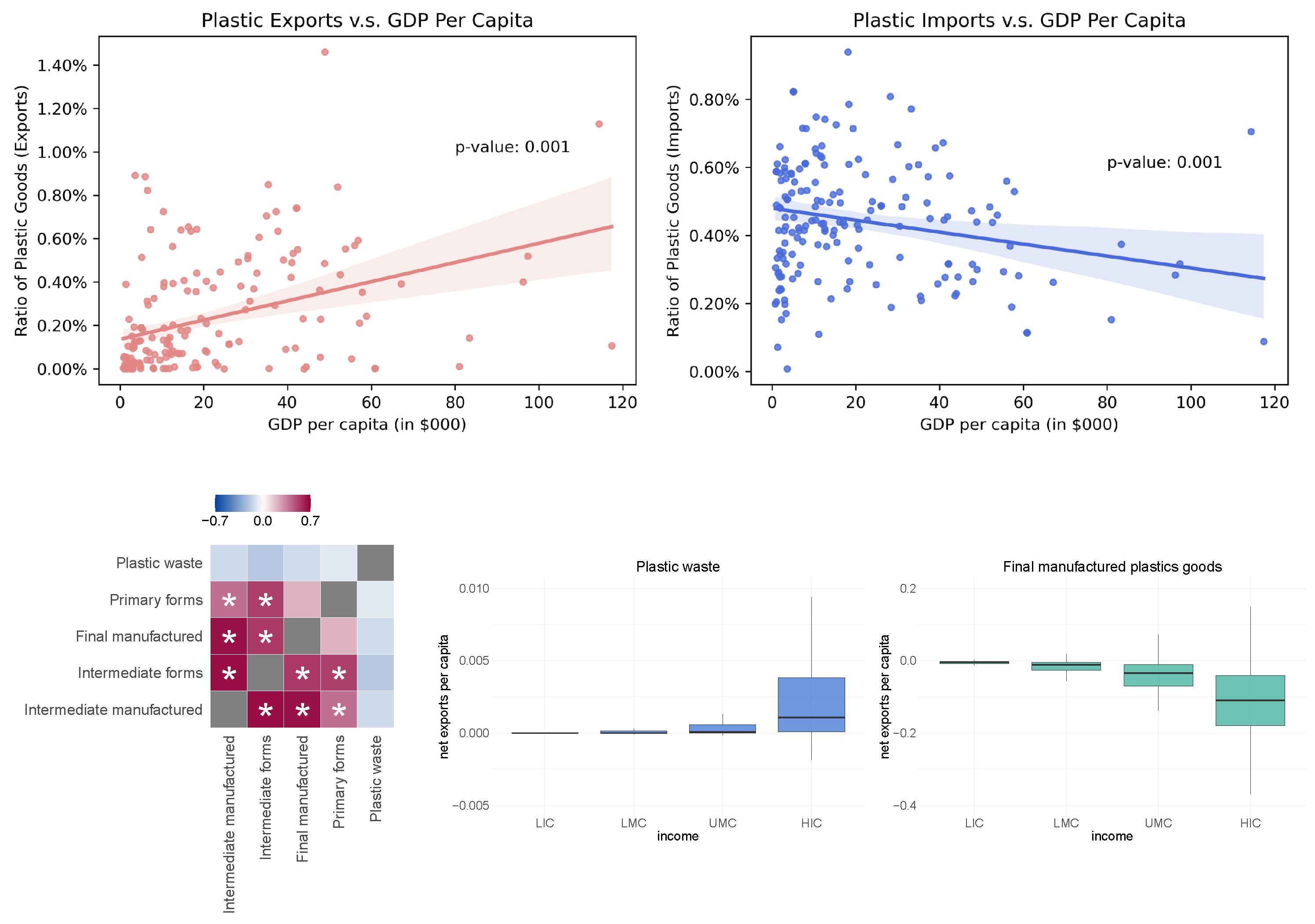
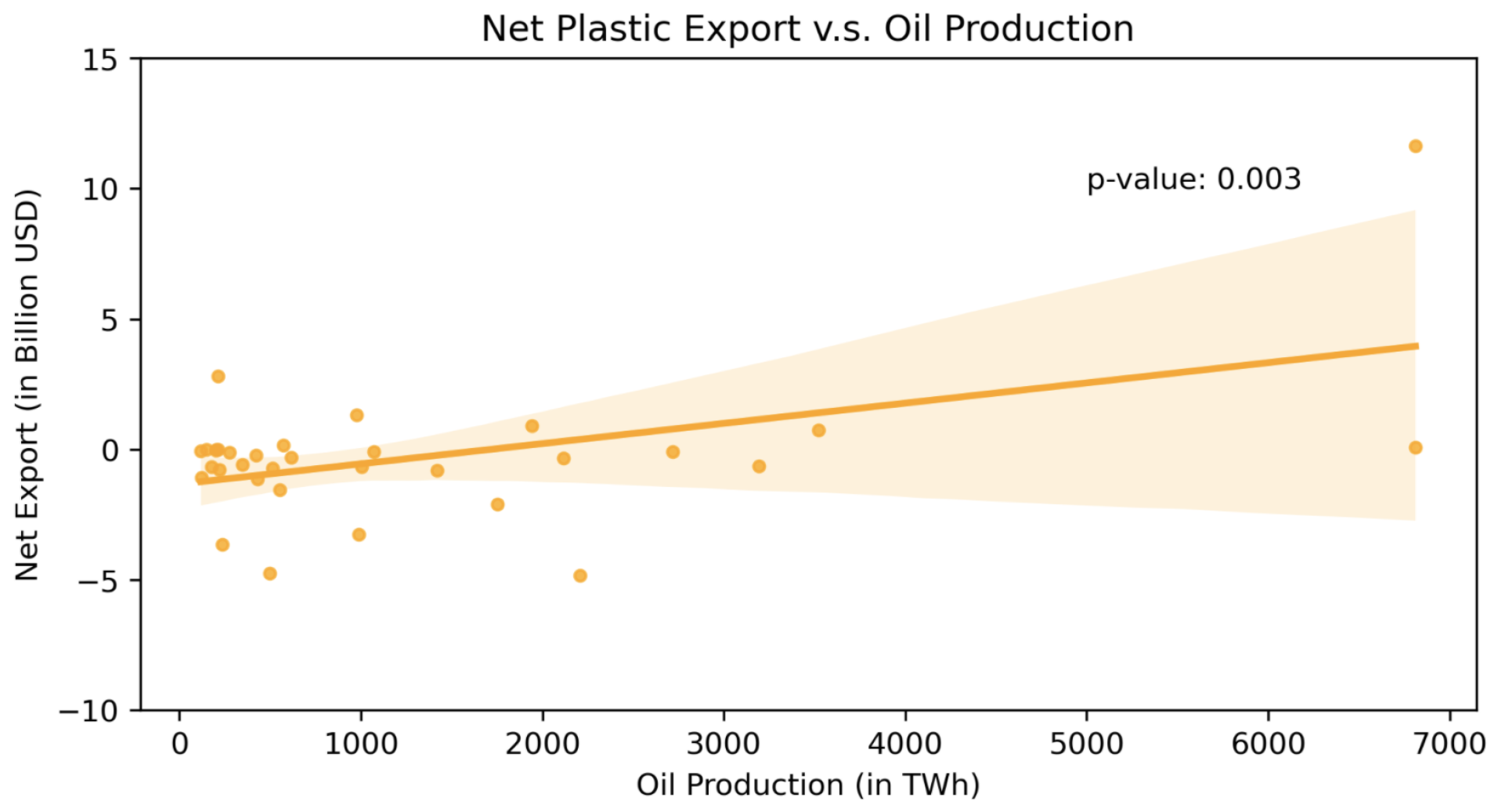

3.2. Optimal Trade Pattern
4. Discussion
4.1. Policy Recommendations
4.1.1. Increase Trade Limit for Plastic Waste
4.1.2. Increase Recycle Rate of Plastic Waste
4.2. Comparison with Literature and Future Directions
5. Conclusions
Author Contributions
Funding
Institutional Review Board Statement
Informed Consent Statement
Data Availability Statement
Conflicts of Interest
Appendix A
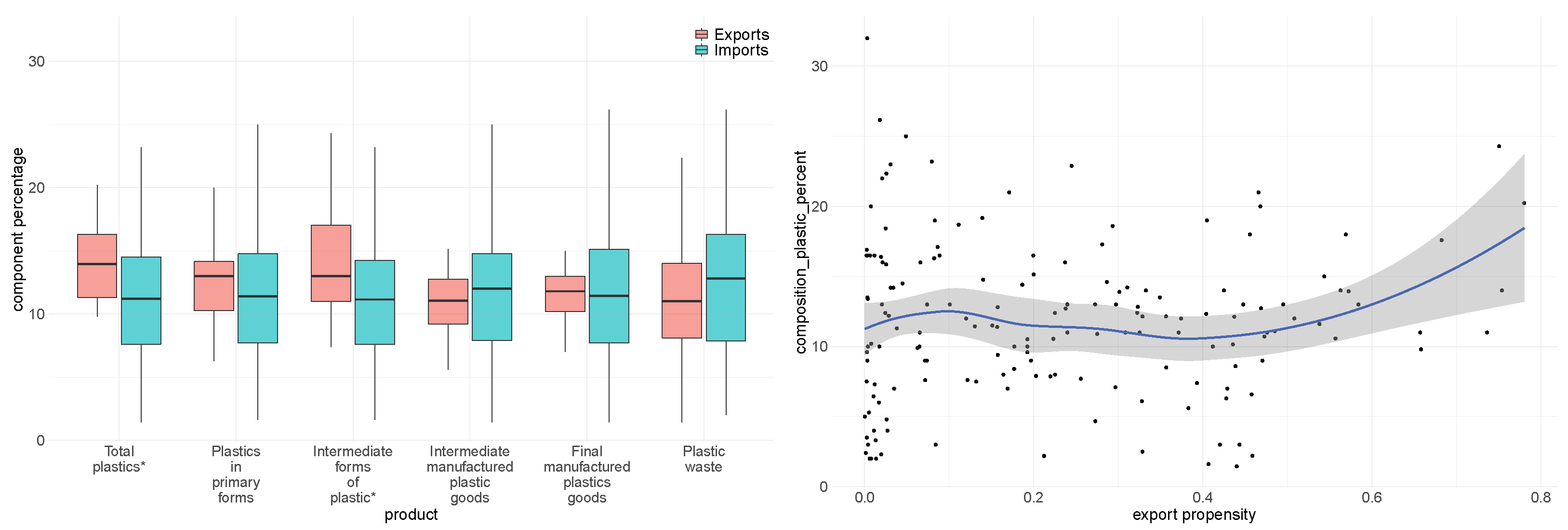
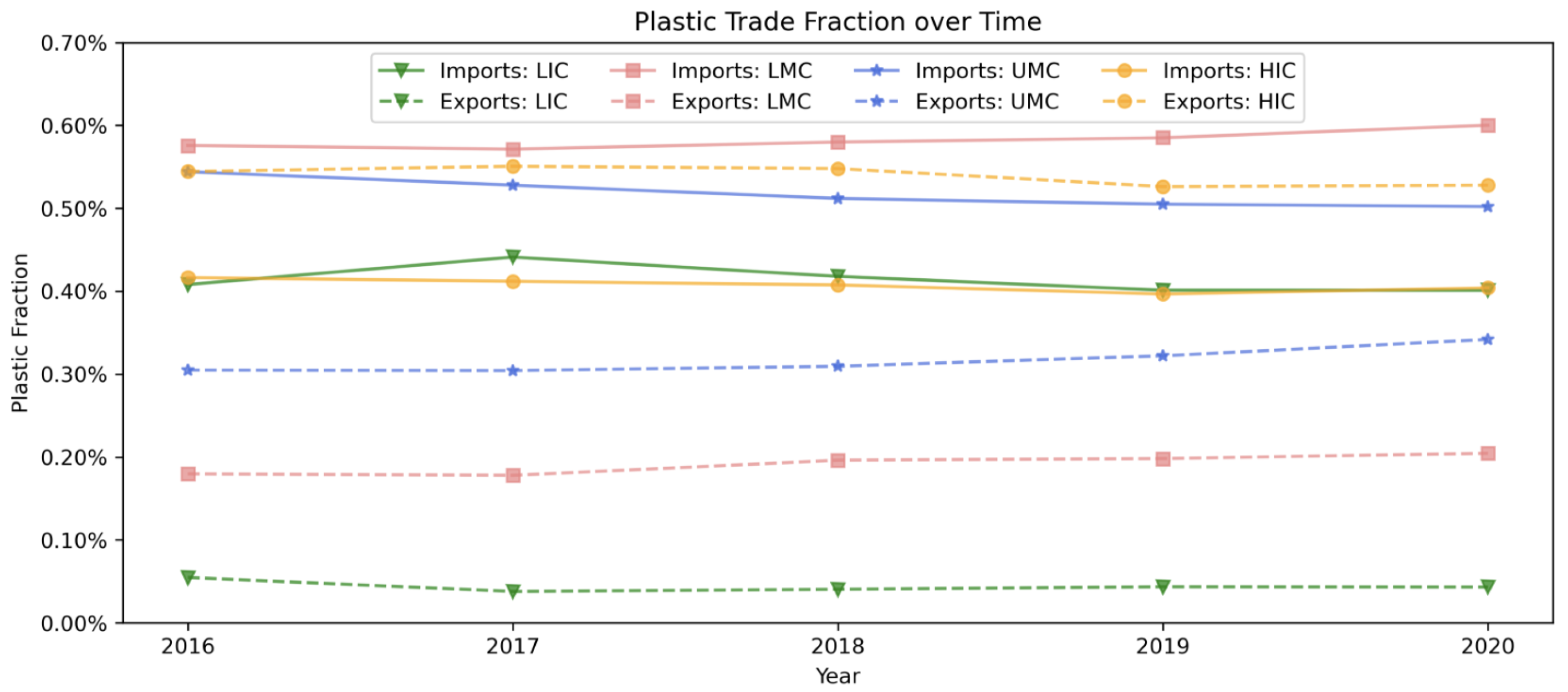

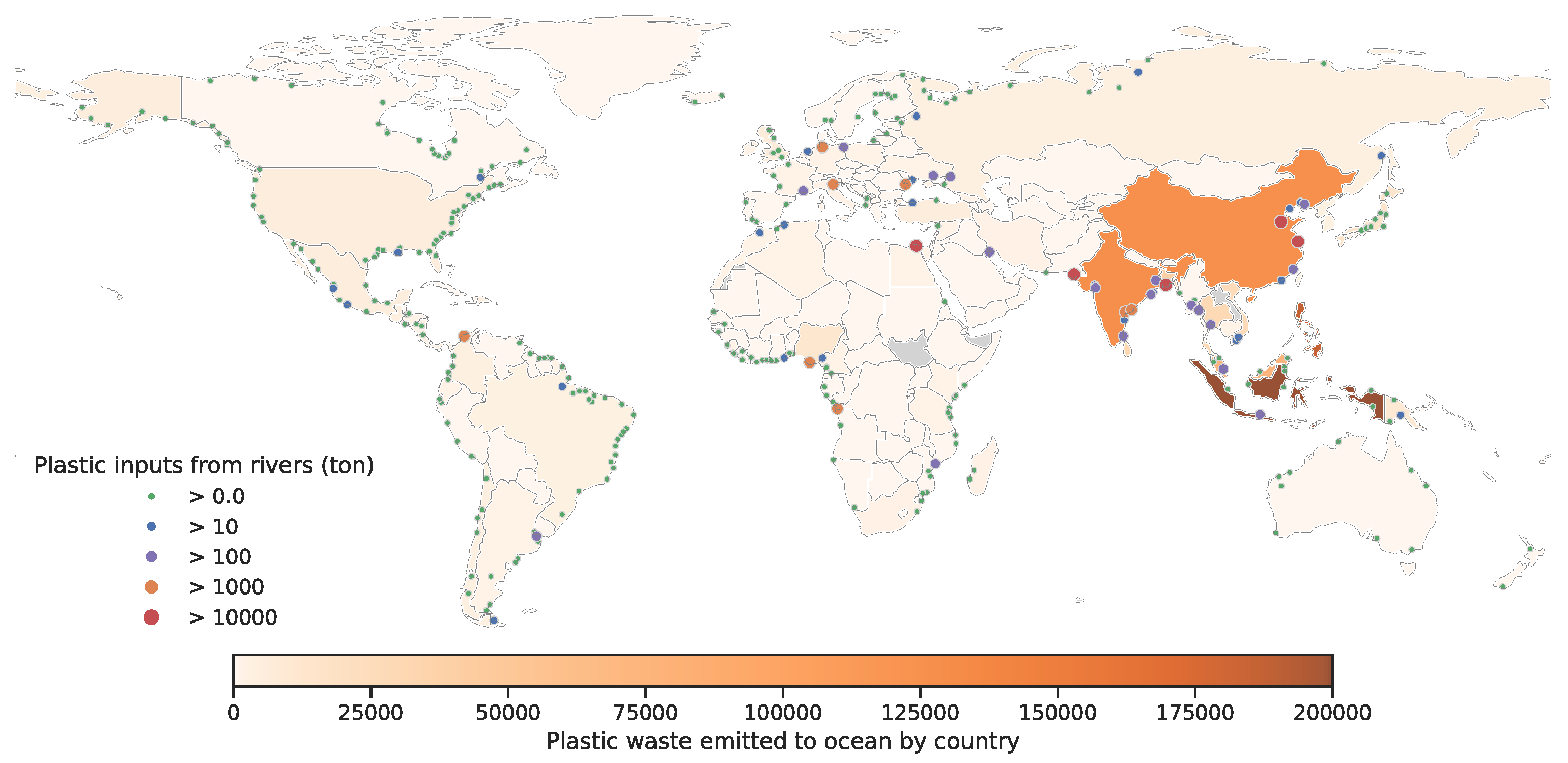
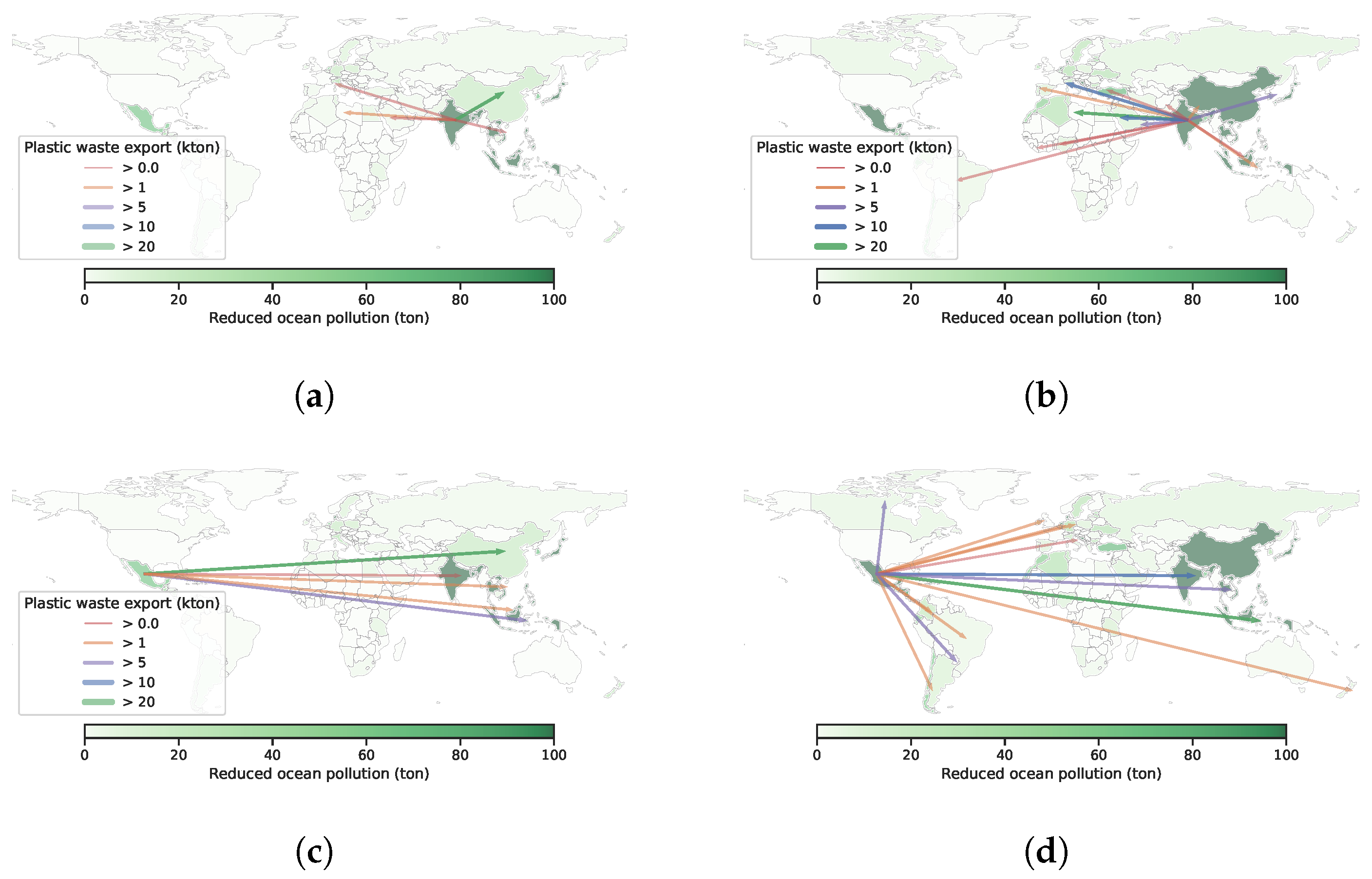
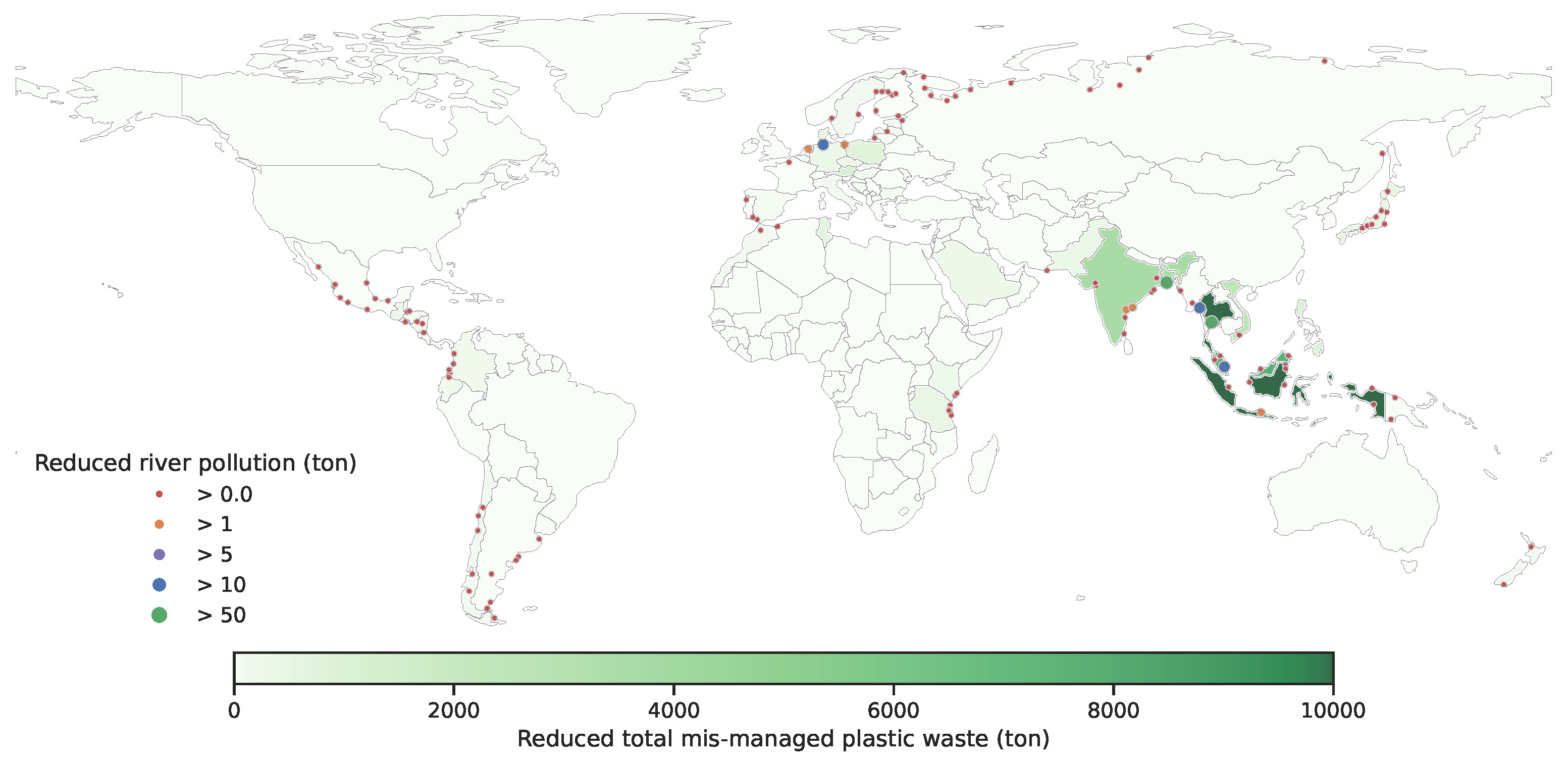
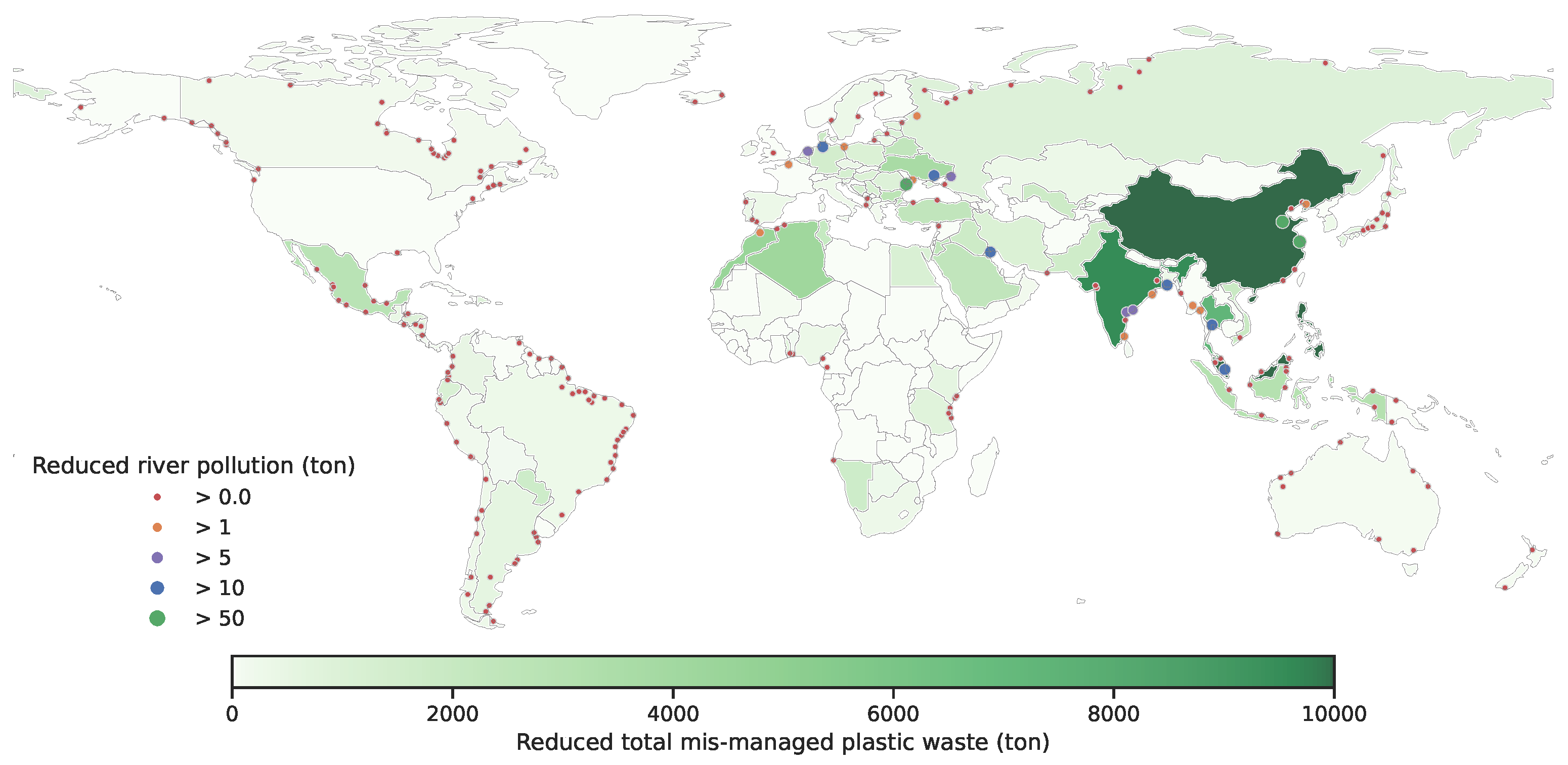
References
- Eriksen, M.; Lebreton, L.C.; Carson, H.S.; Thiel, M.; Moore, C.J.; Borerro, J.C.; Galgani, F.; Ryan, P.G.; Reisser, J. Plastic pollution in the world’s oceans: More than 5 trillion plastic pieces weighing over 250,000 tons afloat at sea. PLoS ONE 2014, 9, e111913. [Google Scholar] [CrossRef] [PubMed]
- Jambeck, J.R.; Geyer, R.; Wilcox, C.; Siegler, T.R.; Perryman, M.; Andrady, A.; Narayan, R.; Law, K.L. Plastic waste inputs from land into the ocean. Science 2015, 347, 768–771. [Google Scholar] [CrossRef] [PubMed]
- LI, W.C.; Tse, H.; Fok, L. Plastic waste in the marine environment: A review of sources, occurrence and effects. Sci. Total Environ. 2016, 566, 333–349. [Google Scholar] [CrossRef] [PubMed]
- Law, K.L. Plastics in the marine environment. Annu. Rev. Mar. Sci. 2017, 9, 205–229. [Google Scholar] [CrossRef] [PubMed]
- Hoornweg, D.; Bhada-Tata, P. What a Waste: A Global Review of Solid Waste Management; World Bank: Washington, DC, USA, 2012. [Google Scholar]
- Gregson, N.; Crang, M. From waste to resource: The trade in wastes and global recycling economies. Annu. Rev. Environ. Resour. 2015, 40, 151–176. [Google Scholar] [CrossRef]
- Ritchie, H.; Roser, M. Plastic Pollution. Our World in Data. 2018. Available online: https://ourworldindata.org/plastic-pollution (accessed on 21 November 2021).
- Barrowclough, D.; Deere-Birkbeck, C.; Christen, J. Global Trade in Plastics: Insights from the First Life-Cycle Trade Database; UNCTAD: Geneva, Switzerland, 2021. [Google Scholar]
- Zhao, C.; Liu, M.; Du, H.; Gong, Y. The evolutionary trend and impact of global plastic waste trade network. Sustainability 2021, 13, 3662. [Google Scholar] [CrossRef]
- Golden, B.L.; Magnanti, T.L.; Nguyen, H.Q. Implementing vehicle routing algorithms. Networks 1977, 7, 113–148. [Google Scholar] [CrossRef]
- Glover, F.; Klingman, D.; Phillips, N.V. Network Models in Optimization and Their Applications in Practice; John Wiley & Sons: Hoboken, NJ, USA, 1992; Volume 36. [Google Scholar]
- Ahuja, R.K.; Magnanti, T.L.; Orlin, J.B. Network Flows: Theory, Applications and Algorithms; Prentice-Hall: Englewood Cliffs, NJ, USA, 1993; Volume 41, pp. 587–602. [Google Scholar]
- Meijer, L.J.; van Emmerik, T.; van der Ent, R.; Schmidt, C.; Lebreton, L. More than 1000 rivers account for 80% of global riverine plastic emissions into the ocean. Sci. Adv. 2021, 7, eaaz5803. [Google Scholar] [CrossRef] [PubMed]
- Peng, Y.; Wu, P.; Schartup, A.T.; Zhang, Y. Plastic waste release caused by COVID-19 and its fate in the global ocean. Proc. Natl. Acad. Sci. USA 2021, 118, e2111530118. [Google Scholar] [CrossRef] [PubMed]
- Schmidt, C.; Krauth, T.; Wagner, S. Export of plastic debris by rivers into the sea. Environ. Sci. Technol. 2017, 51, 12246–12253. [Google Scholar] [CrossRef] [PubMed]
- EPA. National Overview: Facts and Figures on Materials, Wastes and Recycling. Online Report. Available online: https://www.epa.gov/facts-and-figures-about-materials-waste-and-recycling/national-overview-facts-and-figures-materials (accessed on 21 November 2021).
- Shi, Y.; Cameron, B.; Gu, X.; Kane, M.; Peduzzi, P.; Esserman, D.A. Two-stage randomized trial design for testing treatment, preference, and self-selection effects for count outcomes. Stat. Med. 2020, 39, 3653–3683. [Google Scholar] [CrossRef] [PubMed]
- Qi, J.; Zhao, J.; Li, W.; Peng, X.; Wu, B.; Wang, H. Development of Circular Economy in China; Springer: Singapore, 2016. [Google Scholar]
- Brooks, A.L.; Wang, S.; Jambeck, J.R. The Chinese import ban and its impact on global plastic waste trade. Sci. Adv. 2018, 4, eaat0131. [Google Scholar] [CrossRef] [PubMed]
- Hassan, D. Protecting the Marine Environment from Land-Based Sources of Pollution: Towards Effective International Cooperation; Routledge: London, UK, 2017. [Google Scholar]
- Borrelle, S.B.; Rochman, C.M.; Liboiron, M.; Bond, A.L.; Lusher, A.; Bradshaw, H.; Provencher, J.F. Why we need an international agreement on marine plastic pollution. Proc. Natl. Acad. Sci. USA 2017, 114, 9994–9997. [Google Scholar] [CrossRef] [PubMed]
- Dalu, M.T.; Cuthbert, R.N.; Muhali, H.; Chari, L.D.; Manyani, A.; Masunungure, C.; Dalu, T. Is awareness on plastic pollution being raised in schools? Understanding perceptions of primary and secondary school educators. Sustainability 2020, 12, 6775. [Google Scholar] [CrossRef]
- Kumar, R.; Verma, A.; Shome, A.; Sinha, R.; Sinha, S.; Jha, P.K.; Kumar, R.; Kumar, P.; Das, S.; Sharma, P.; et al. Impacts of plastic pollution on ecosystem services, sustainable development goals, and need to focus on circular economy and policy interventions. Sustainability 2021, 13, 9963. [Google Scholar] [CrossRef]
- Vingwe, E.; Towa, E.; Remmen, A. Danish plastic mass flows analysis. Sustainability 2020, 12, 9639. [Google Scholar] [CrossRef]
- Moy, C.H.; Tan, L.S.; Shoparwe, N.F.; Shariff, A.M.; Tan, J. Comparative study of a life cycle assessment for bio-plastic straws and paper straws: Malaysia’s perspective. Processes 2021, 9, 1007. [Google Scholar] [CrossRef]
- Rajeswari, T.R.; Sailaja, N. Impact of heavy metals on environmental pollution. J. Chem. Pharm. Sci. 2014, 3, 175–181. [Google Scholar]
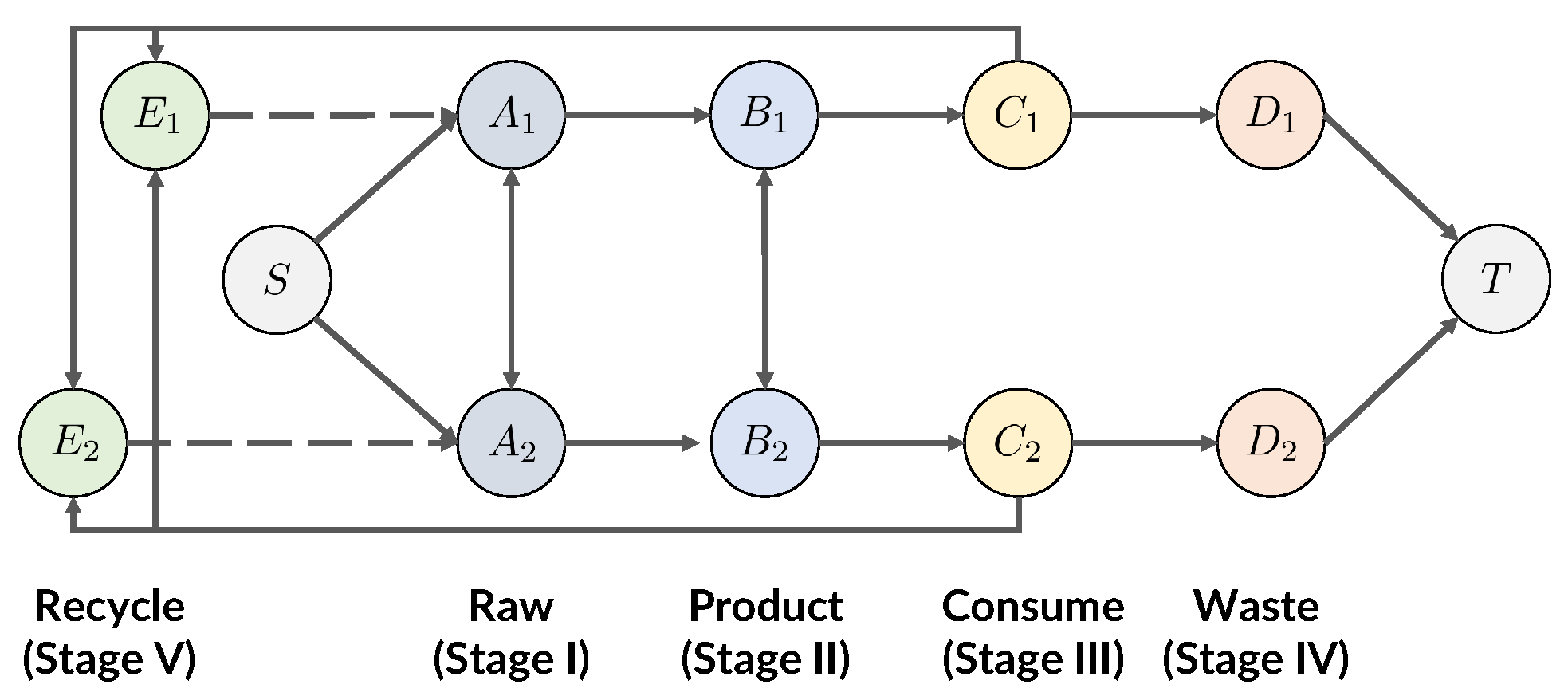
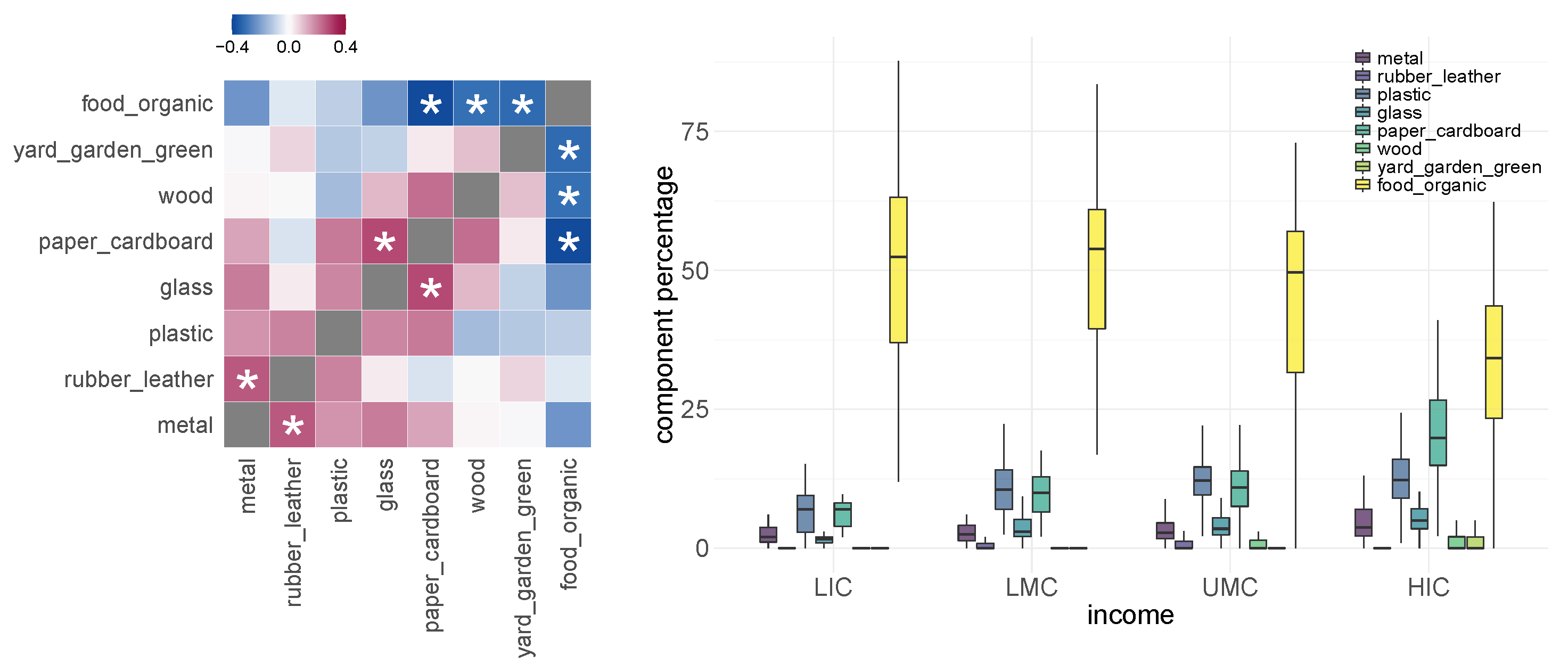
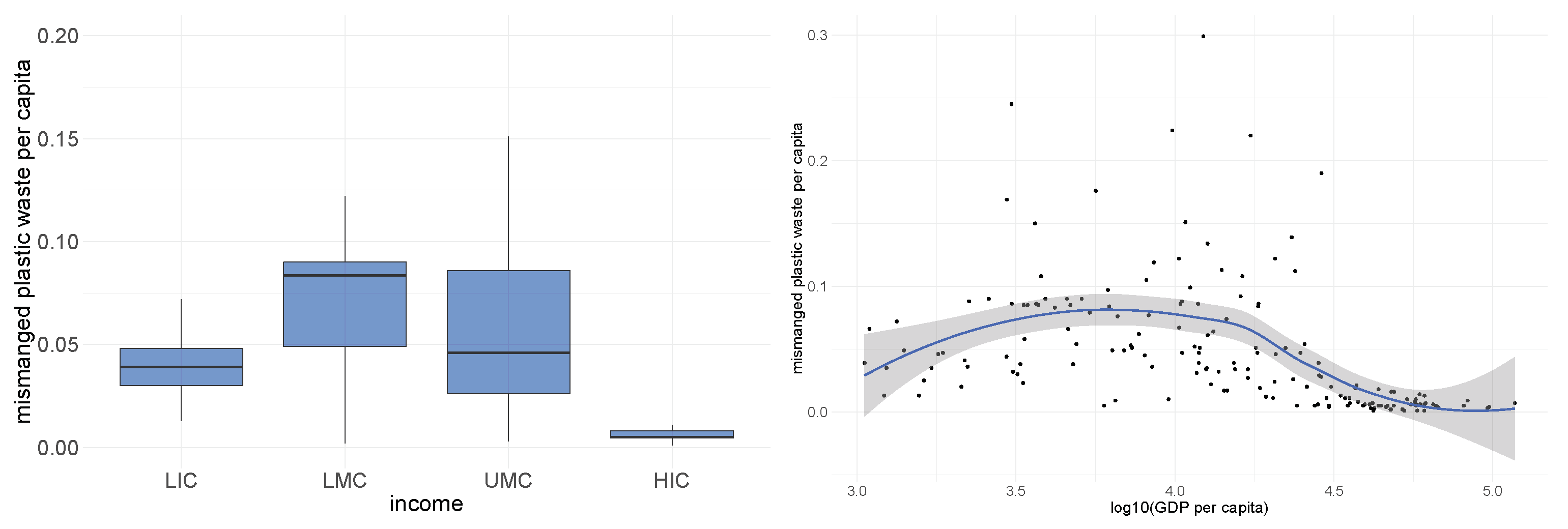
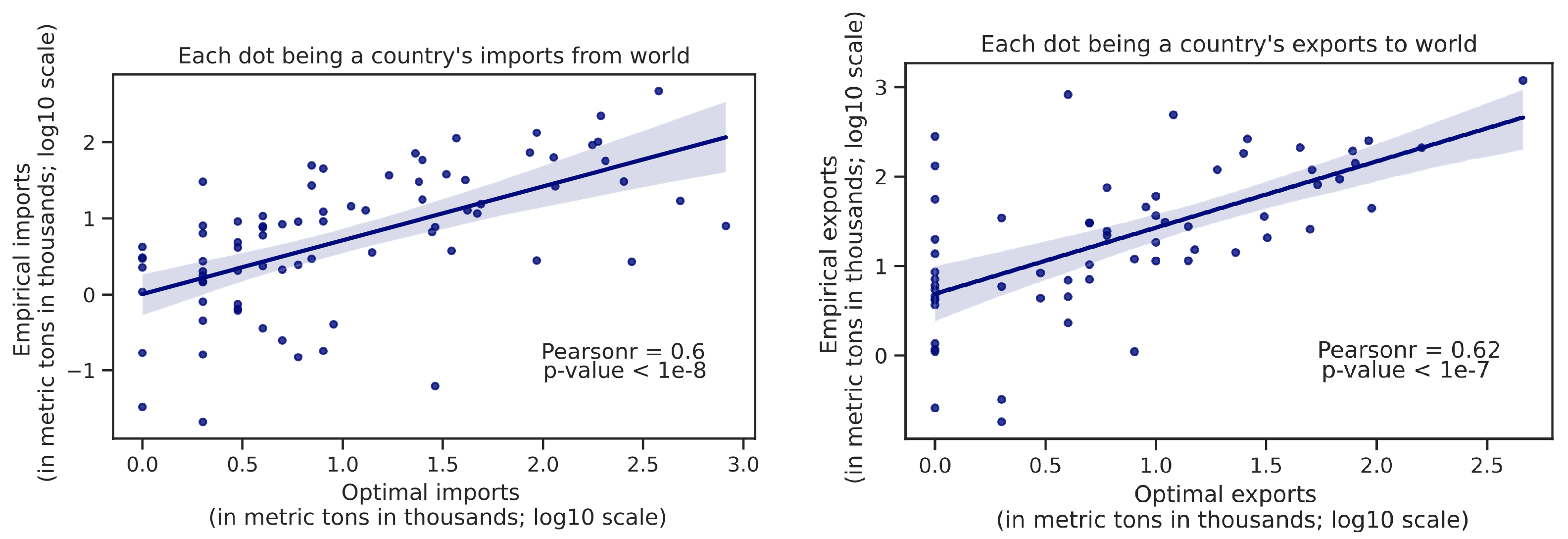
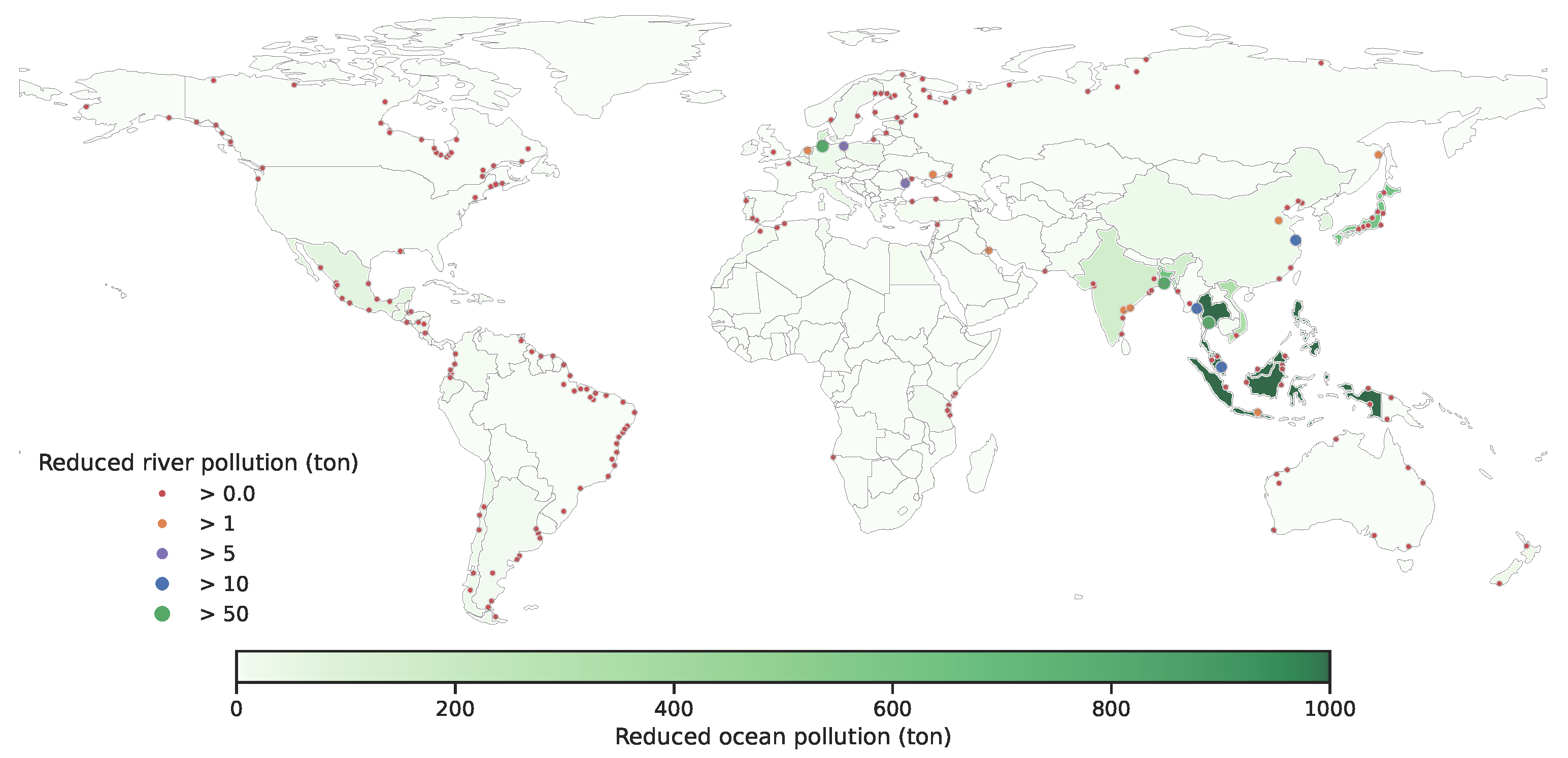
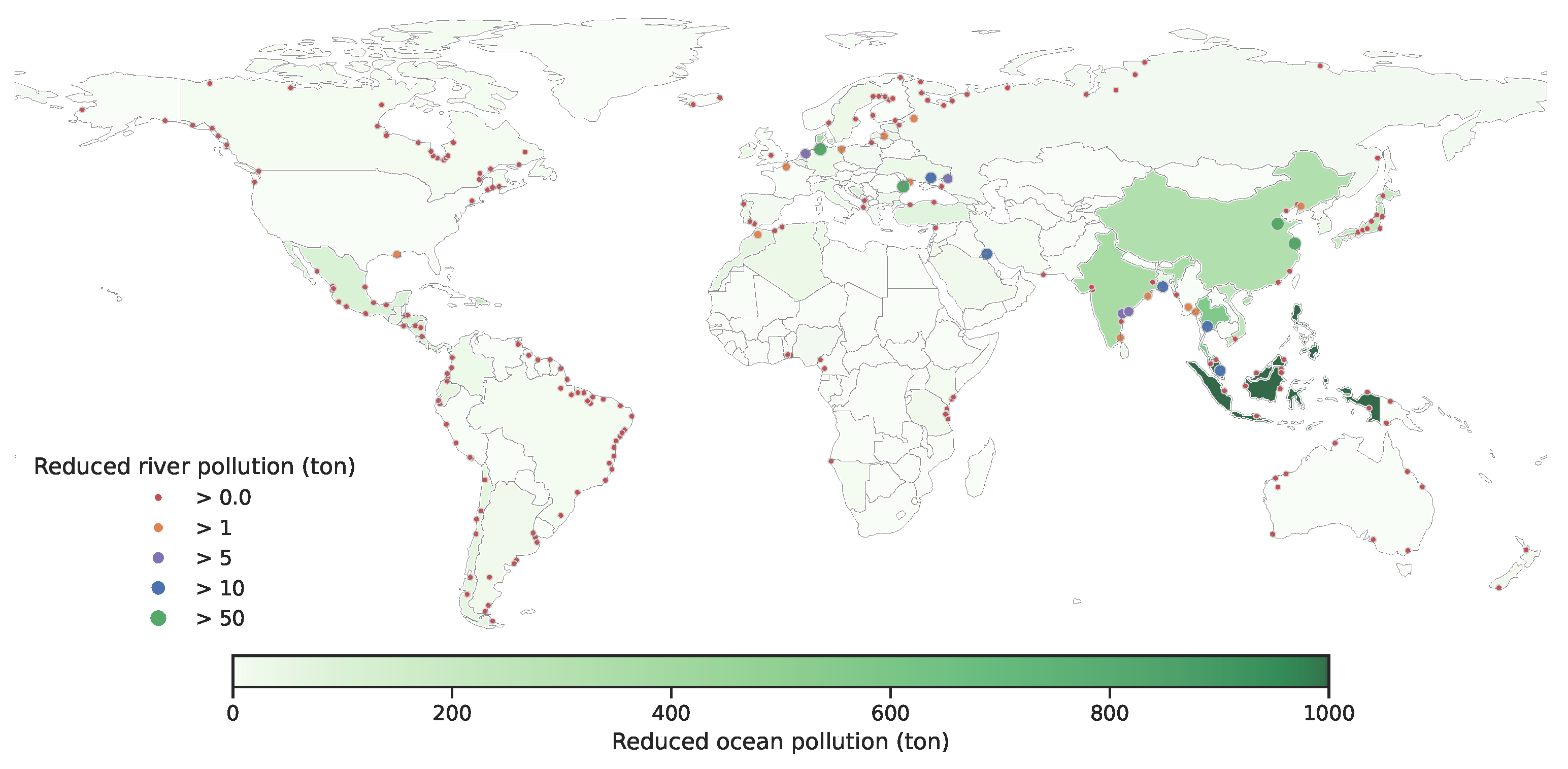
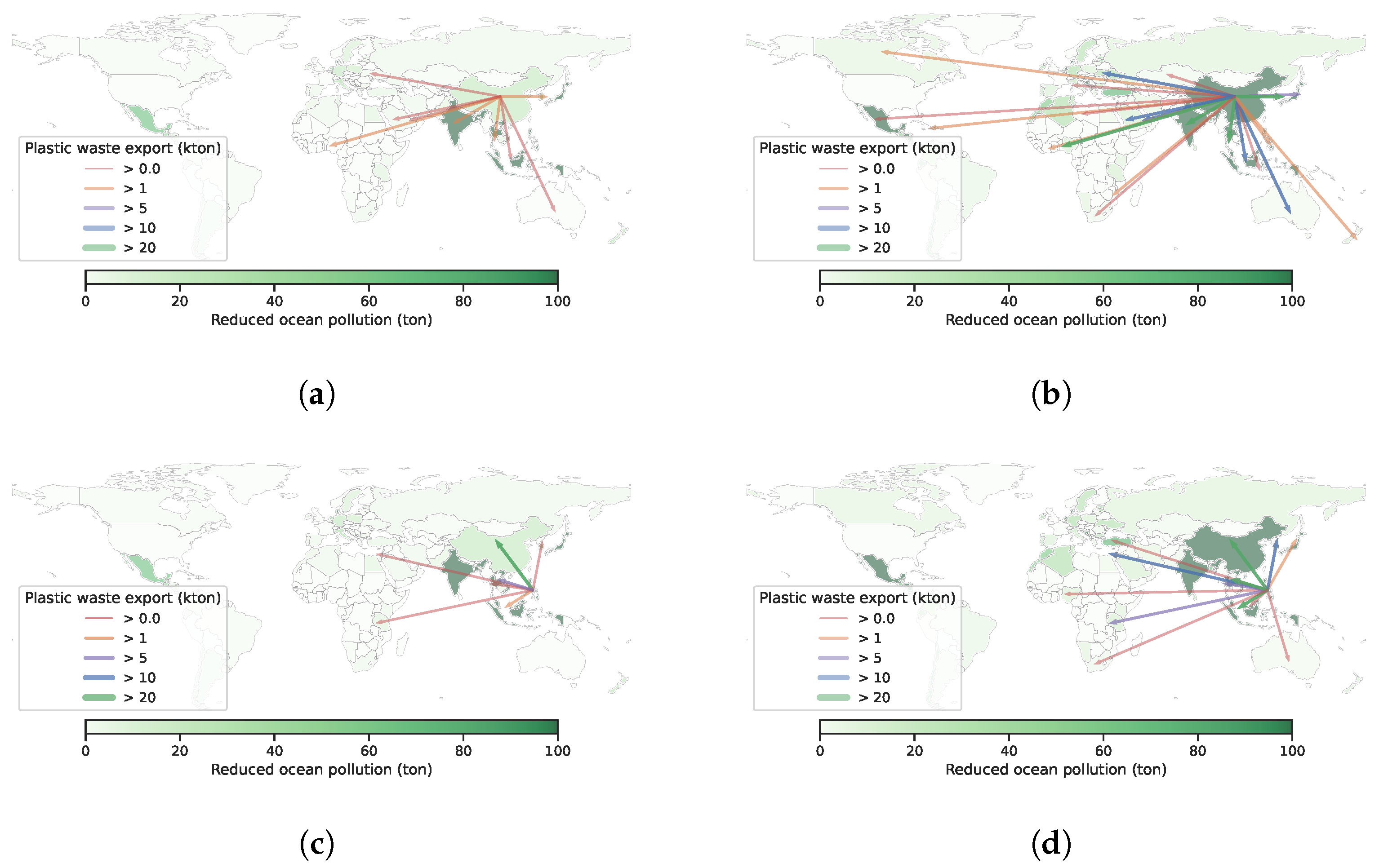

Publisher’s Note: MDPI stays neutral with regard to jurisdictional claims in published maps and institutional affiliations. |
© 2022 by the authors. Licensee MDPI, Basel, Switzerland. This article is an open access article distributed under the terms and conditions of the Creative Commons Attribution (CC BY) license (https://creativecommons.org/licenses/by/4.0/).
Share and Cite
Li, D.; Liu, C.; Shi, Y.; Song, J.; Zhang, Y. Trade Flow Optimization Model for Plastic Pollution Reduction. Int. J. Environ. Res. Public Health 2022, 19, 15963. https://doi.org/10.3390/ijerph192315963
Li D, Liu C, Shi Y, Song J, Zhang Y. Trade Flow Optimization Model for Plastic Pollution Reduction. International Journal of Environmental Research and Public Health. 2022; 19(23):15963. https://doi.org/10.3390/ijerph192315963
Chicago/Turabian StyleLi, Daming, Canyao Liu, Yu Shi, Jiaming Song, and Yiliang Zhang. 2022. "Trade Flow Optimization Model for Plastic Pollution Reduction" International Journal of Environmental Research and Public Health 19, no. 23: 15963. https://doi.org/10.3390/ijerph192315963
APA StyleLi, D., Liu, C., Shi, Y., Song, J., & Zhang, Y. (2022). Trade Flow Optimization Model for Plastic Pollution Reduction. International Journal of Environmental Research and Public Health, 19(23), 15963. https://doi.org/10.3390/ijerph192315963







